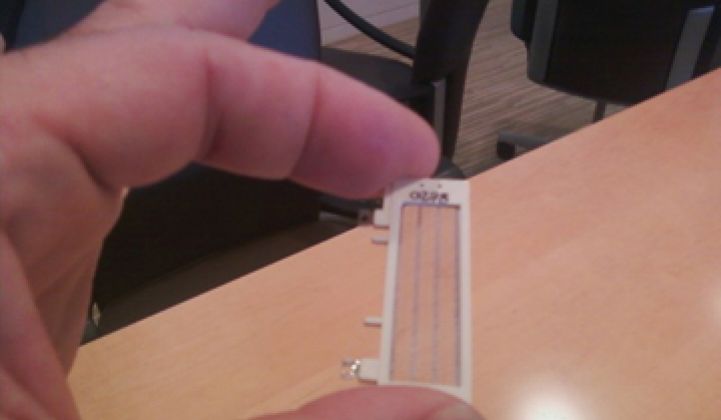It's a fan with no moving parts. That's how Ventiva CEO Carl Schlachte describes his company's cornerstone product.
Ventiva has come up with a wire grid that effectively cools light emitting diodes, solid state lights and other electronic components in a way that can be considered both active and passive. It works as follows: A small charge is applied to some of the wires in Ventiva's mesh. This creates ions in the localized atmosphere. The ions begin to move and push against molecules in the air, which in turn creates a breeze.
It's passive in that it doesn't have mechanical moving parts, but active in that heat gets removed by an air current generated by a component. (See photo.)
"We can remove 20 to 30 watts of heat" from an LED bulb, and more heat with a larger array of wires, Schlachte said during an impromptu meeting and presentation at the SD Forum in San Francisco recently.
Ventiva has even built plastic light fixtures that don't melt to prove its cooling power to engineers. Schlachte was going to demonstrate it at Lightfair last May, but TSA employees disassembled it as he boarded his flight to Philadelphia.
"They left a note saying, 'It is not a bomb,'" he said.
The company is one of a number of companies trying to tackle the thorny problem of heat management in lighting. Although the light from LED bulbs is not hot, the chips that generate the light get quite hot. Many manufacturers recommend that consumers put certain LED bulbs only in lamps, not downward-facing ceiling lights. Ceiling cans may trap heat and cause electrical problems.
Unfortunately, heat dissipation is not a glamorous problem either and companies have to compete against the incredibly inexpensive aluminum heat sinks that Taiwanese and Chinese manufacturers can crank out by the millions. Add on top of that the fact that many of these new cooling devices require their own small doses of energy to work. Ventiva was founded in 2002 out of research conducted at Purdue and it is still an emerging company: that's how long these things can take.
Nuventix takes a different approach. It has invented a component, called a SynJet, that creates a vortex of air to dissipate heat. A vortex functions like a mini-tornado, creating a large amount of rotational force quickly. Companies such as PARC, Epuramat and Watreco are also trying to harness the power of vortices for water purification and algae separation.
General Electric this week said it would license the technology. GE also participated in a $10 million round of funding. Founded in 2005 out of research conducted by Georgia Tech, Nuventix raised $32.5 million between 2005 and 2009 and, like Ventiva, is really only graduating toward commercial adoption. Interestingly, GE showed off its own jet cooling technology last year developed in conjunction with the University of Maryland. Whether GE will combine these two efforts remains to be seen.
A third option is liquid cooling. Progressive Cooling Solutions in Berkeley has created a liquid-filled membrane to eliminate heat. Switch Lighting, meanwhile, will release toward the end of the year an LED bulb filled with liquid. By filling the bulb of the bulb with liquid, switch takes some of the heating workload off of the aluminum heat sink. In turn, that allows Switch to crank up the power on the LEDs inside the bulb and reduce the number of components at the same time. The end result is a cheaper bulb that puts out the same amount of light as one with a conventional heat removal strategy. Additionally, the bulb -- being liquid filled and all -- serves as a conversation piece.



